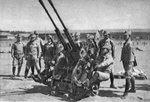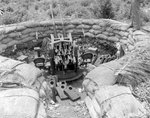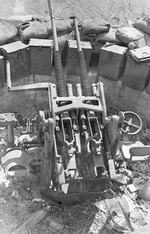25 mm Hotchkiss Anti-Aircraft Gun
| Country of Origin | France |
| Type | Anti-Aircraft Gun |
| Caliber | 25.000 mm |
| Capacity | 15 rounds |
| Barrel Length | 1.500 m |
| Weight | 785.000 kg |
| Ammunition Weight | 0.68 kg |
| Rate of Fire | 220 rounds/min |
| Ceiling | 2.000 km |
| Muzzle Velocity | 900 m/s |
Contributor: C. Peter Chen
ww2dbaseThe Hotchkiss 25-millimeter anti-aircarft guns were developed in France in the 1930s. Because the French military rejected the design due to its slow rate of fire of 200 to 260 rounds per minute, Hotchkiss decided to export these weapons abroad, instead.In 1935, Spain purchased 5 examples. The were delivered in Jan 1936 and were mounted on destroyers Jose Luis Díez, Lepanto, and Ulloa.
In 1935, several production examples were sent to Japan as the Japanese Navy searched for modern replacements for the older British-built Vickers 40-millimeter "pom-pom" anti-aircraft guns. They were tested at the Yokosuka Naval Arsenal in Japan under the designations of Type 94 and Type 95. In 1936, the Yokosuka Naval Arsenal began license-building them as Type 96. The Japanese version of the Hotchkiss 25-millimeter anti-aircraft guns had some simpler components for ease of production, and the conical flash suppressors were swapped with those built by the German firm Rheinmetall. The first Japanese Navy versions were built as double-mounted weapons at the weight of 1,100 kilograms; triple mounts (1,800 kilograms) were introduced in 1941 and single mounts (785 kilograms) were introduced in 1943. The Japanese military estimated that 1,500 rounds were required for each Type 96 mount to take down an American aircraft at a height of 1,000 meters and a range of 2,000 meters, and beyond that range the weapon was fairly ineffective. Late in the war, with ammunition in short supply, the Japanese Navy ordered that enemy aircraft must come within 800 meters before Type 96 gun crews were permitted to open fire. Despite the slow firing rate, Japanese gunners often cited this weapon as the most reliable anti-aircraft weapon of the war. Late in the war, they were also used as anti-tank guns. Between 1936 and 1945, 33,000 examples were built in Japan.
In 1938, the Schneider 37 mm autocannon design, the design that the French military had chosen over that from Hotchkiss, was not ready for production, thus the rejection previously issued to Hotchkiss was retracted. At that time, Hotchkiss had just begun the production to export the 25-millimeter guns to Romania; these examples were held for French service instead of being shipped to Romania. By the time the Germans attacked France in May 1940, a few hundred mounts were in service and contributed in the defense.
In 1943, during German occupation, France re-signed the contract with Romania. The 25-millimeter guns captured by the Germans were shipped to Romania to fulfill the contract.
Source: Wikipedia ww2dbase
Last Major Revision: Jul 2011
25 mm Hotchkiss Anti-Aircraft Gun Interactive Map
Photographs
 |  |  |  |
Please consider supporting us on Patreon. Even $1 per month will go a long way! Thank you. Please help us spread the word: Stay updated with WW2DB: |
Search WW2DB
News
- » US Government Plans to Purge WW2 Information (17 Mar 2025)
- » WW2DB's 20th Anniversary (29 Dec 2024)
- » Wreck of USS Edsall Found (14 Nov 2024)
- » See all news
25 mm Hotchkiss Anti-Aircraft Gun Photo Gallery
 |
Current Site Statistics
- » 1,167 biographies
- » 337 events
- » 44,601 timeline entries
- » 1,243 ships
- » 350 aircraft models
- » 207 vehicle models
- » 376 weapon models
- » 123 historical documents
- » 261 facilities
- » 470 book reviews
- » 28,511 photos
- » 367 maps
Famous WW2 Quote
"You ask, what is our aim? I can answer in one word. It is victory. Victory at all costs. Victory in spite of all terrors. Victory, however long and hard the road may be, for without victory there is no survival."Winston Churchill
Support Us
Please consider supporting us on Patreon. Even $1 a month will go a long way. Thank you!
Or, please support us by purchasing some WW2DB merchandise at TeeSpring, Thank you!